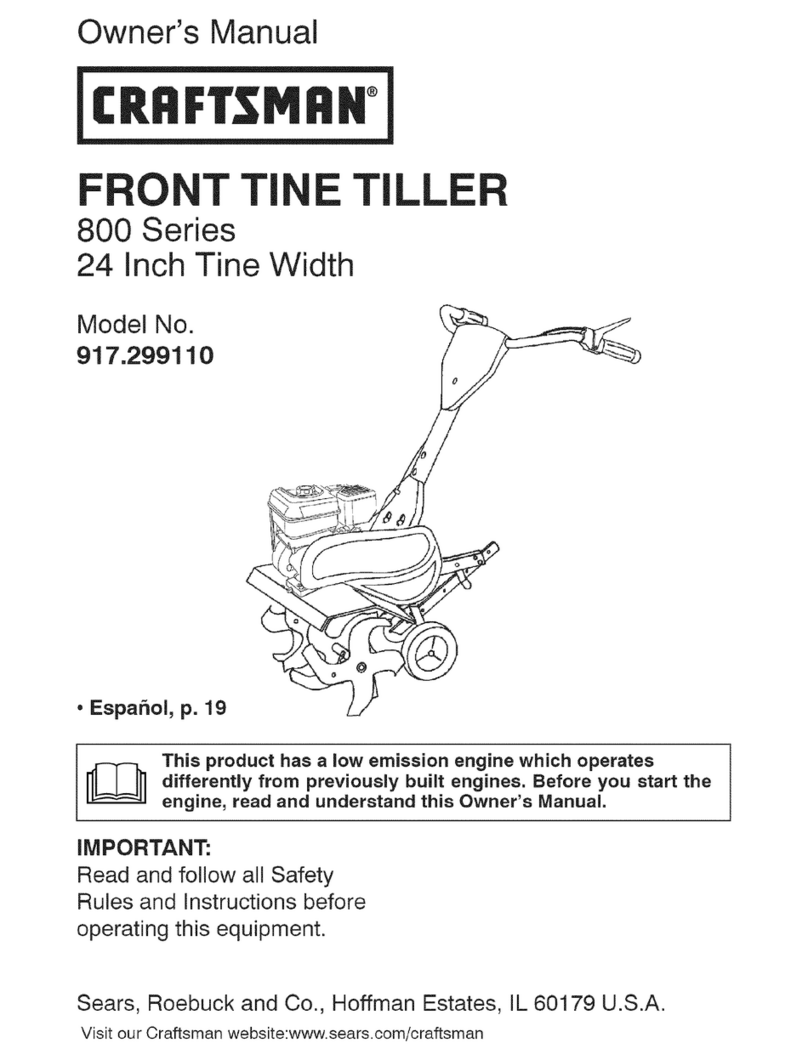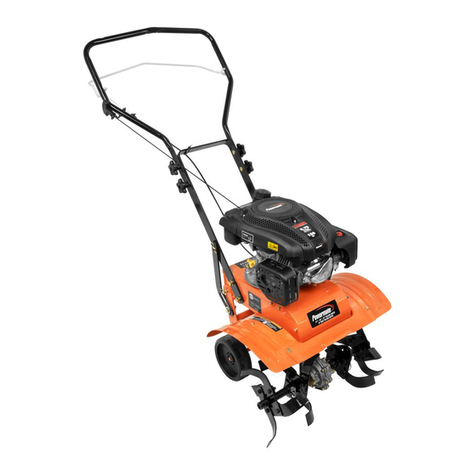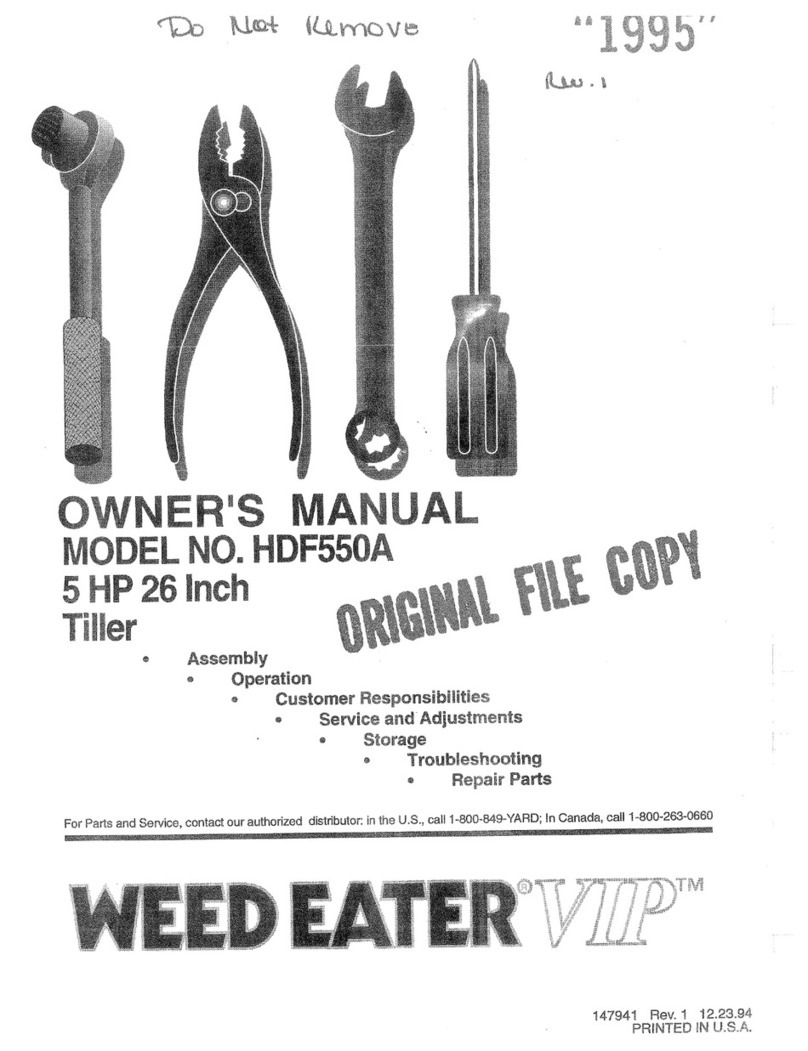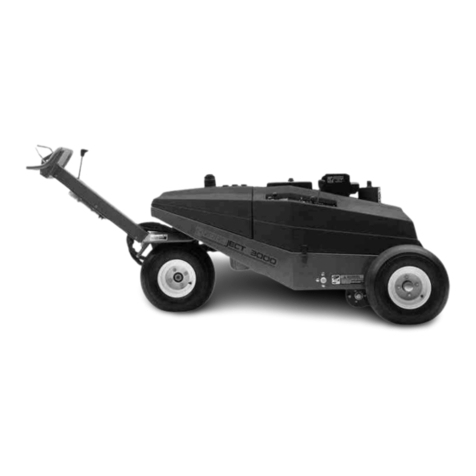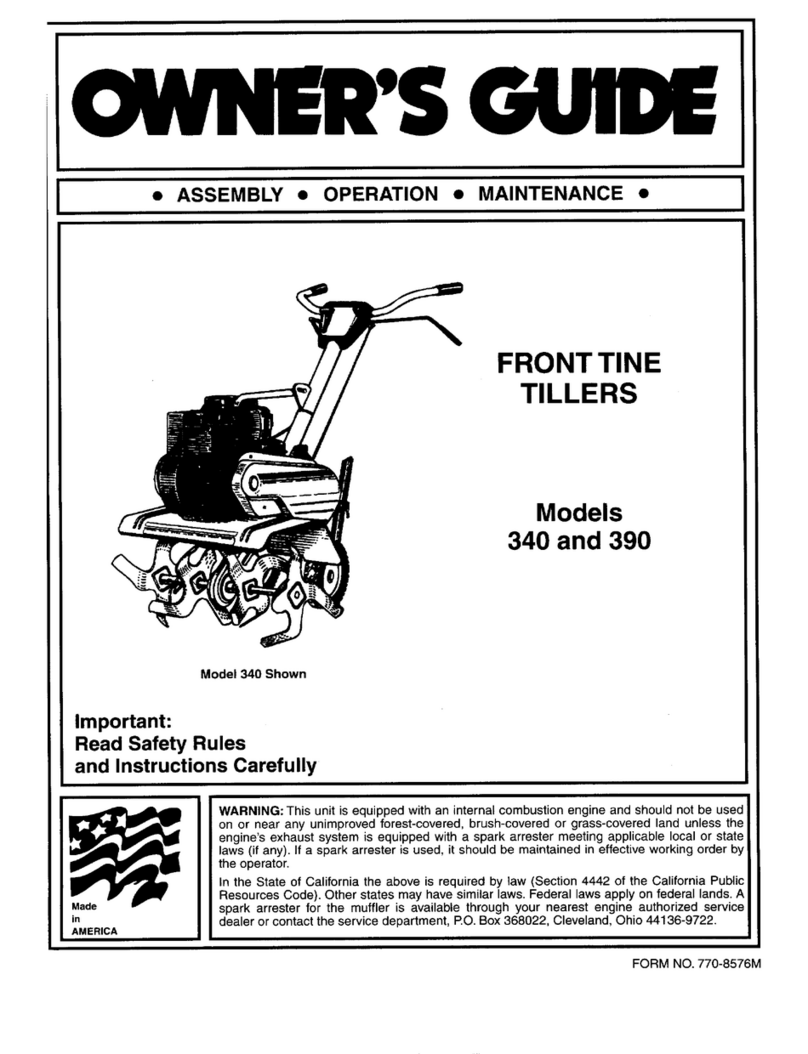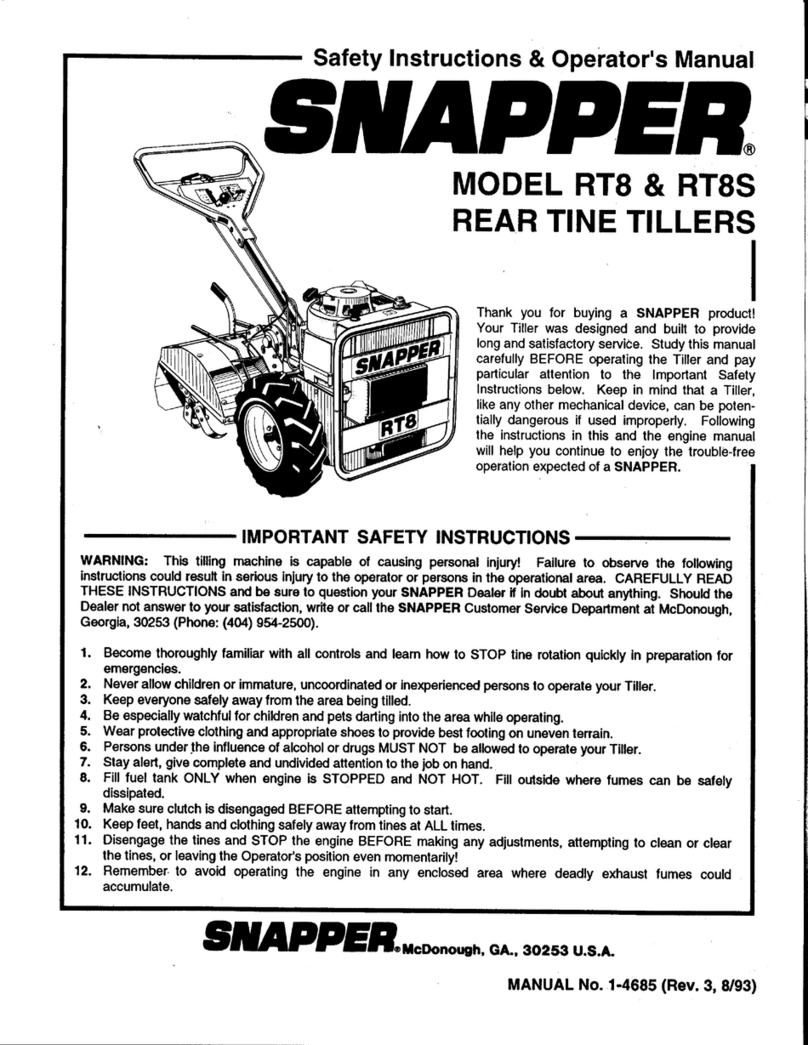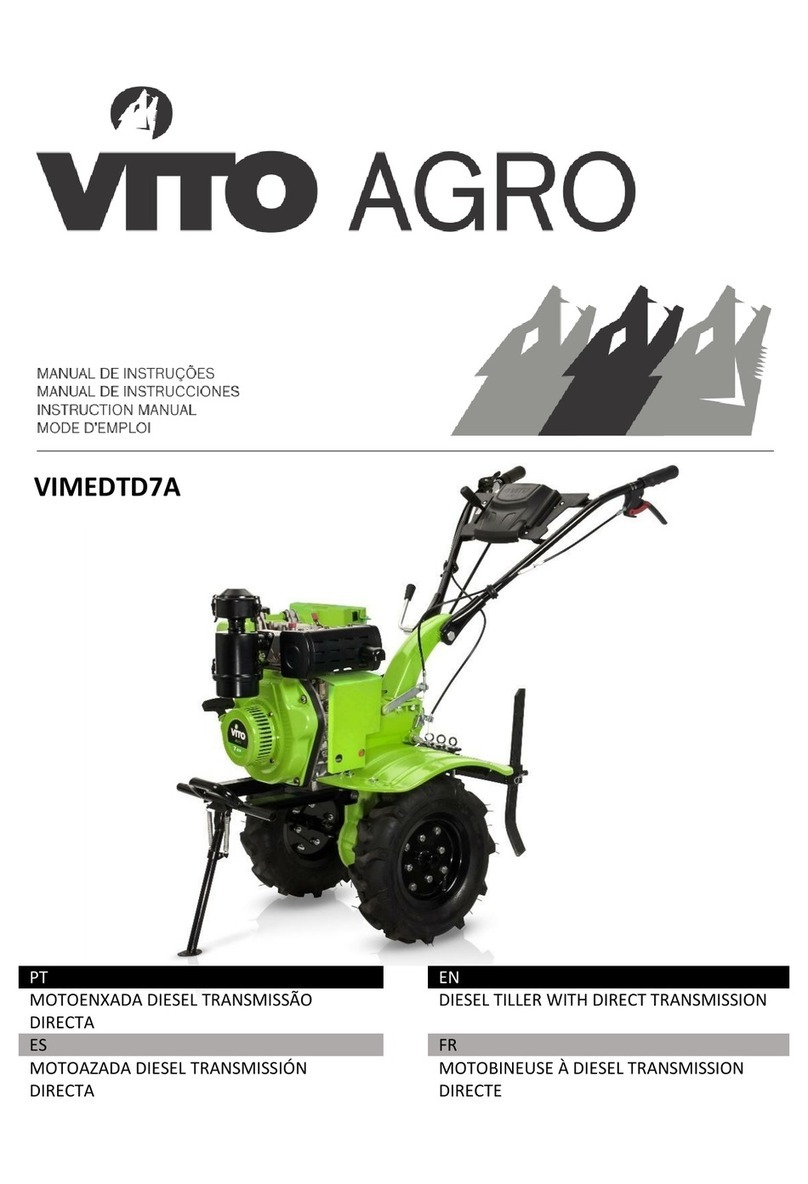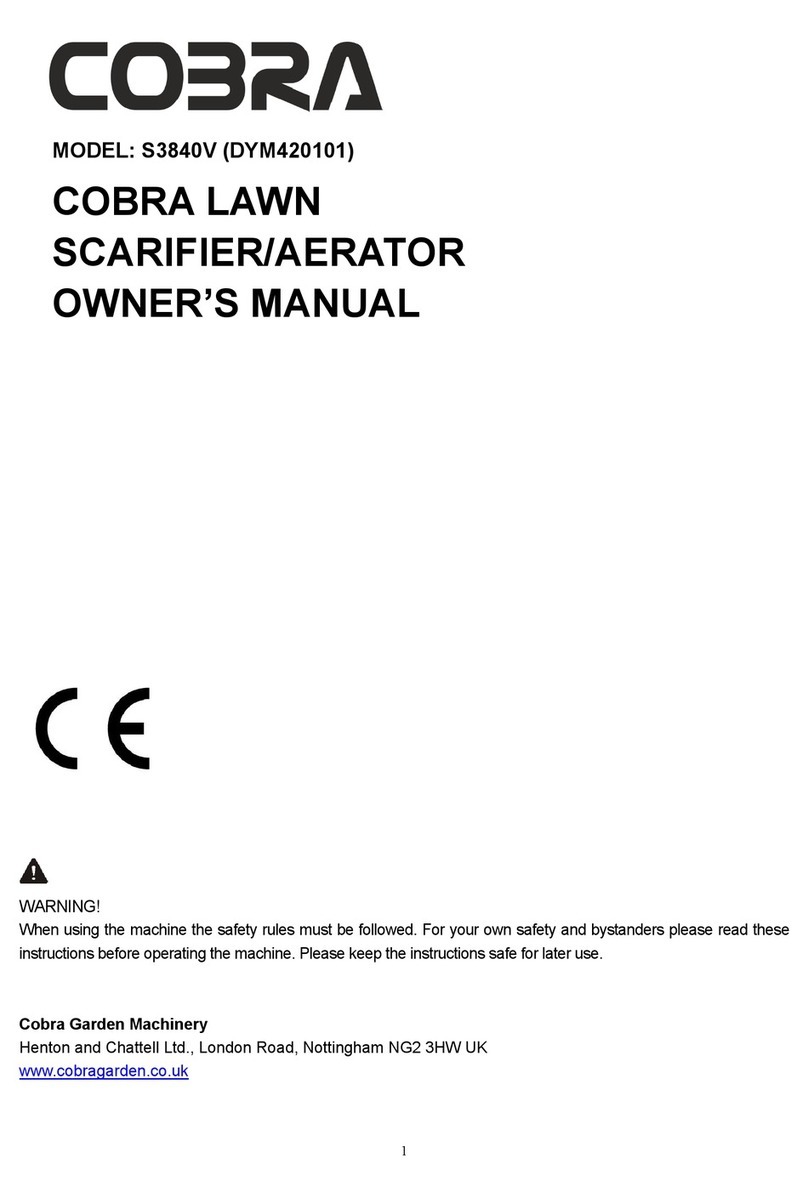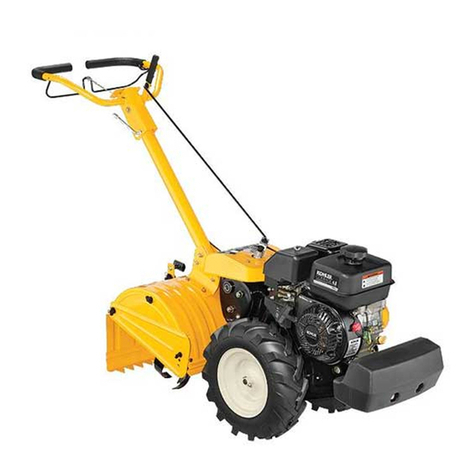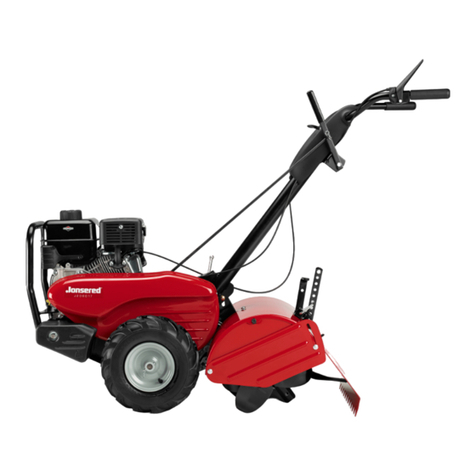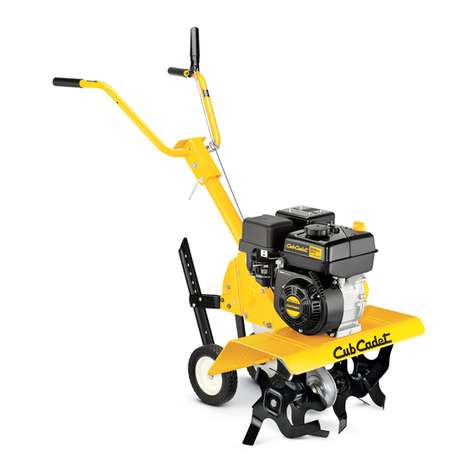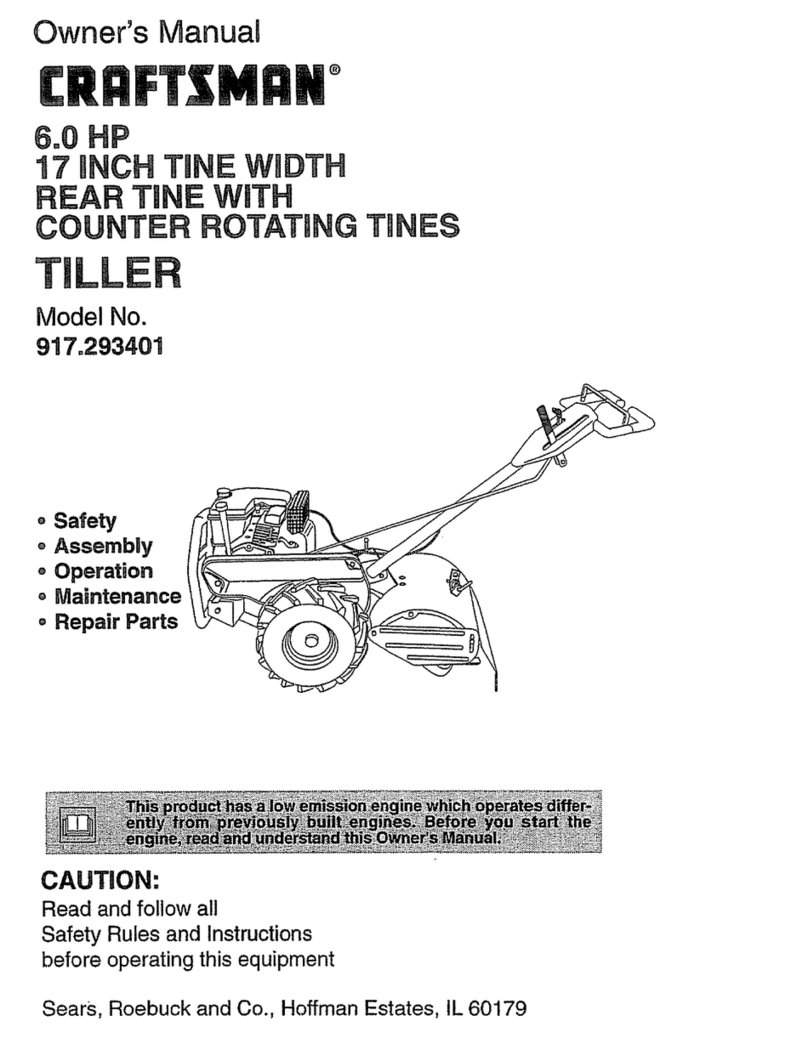Gearmore ARENA-VATOR III AV3-4 User manual

ARENA-VATOR III
Assembly/Operator's/Parts Manual
For Models
AV3-4, AV3-5, AV3-6,
AV3-7, & AV3-8
June 2020
Form: ArenaVatorIII

TABLE OF CONTENTS
SECTION DESCRIPTION
PAGE
1 Introduction .............................................................. 1
1.1 Serial Number Location .......................................... 1
2 Safety............................................................................ 2
2.1 General Safety ......................................................... 3
2.2 Equipment Safety Guidelines ................................. 4
2.3 Safety Training ........................................................ 5
2.4 Safety Signs ............................................................. 5
2.5 Preparation .............................................................. 6
2.6 Operating Safety...................................................... 7
2.7 Transport Safety...................................................... 8
2.8 Storage Safety.......................................................... 8
2.9 Maintenance Safety................................................. 8
3 Safety Sign Locations............................................... 9
4 Operation .................................................................. 10
4.1 To the New Operator or Owner ............................ 10
4.2 Machine Components ............................................ 11
4.3 Machine Break-In.................................................. 11
4.4 Pre-Operation Checklist........................................ 11
4.5 Field Operation............................................... 12 - 15
4.6 Transporting .......................................................... 16
4.7 Storage ................................................................... 16
5 Service & Maintenance.......................................... 17
5.1 Service .................................................................... 17
5.1.1 Fluids and Lubricants ....................................... 17
5.1.2 Greasing ............................................................. 17
5.1.3 Servicing Intervals ............................................ 18
5.1.4 Service Record.................................................... 18
6 Trouble Shooting..................................................... 19
7 Assembly.............................................................20 - 21
8 Specifications ........................................................... 22
8.1 Mechanical ............................................................. 22
8.2 Bolt Torque............................................................. 22
9 Parts Reference ....................................................... 23
9.1 Arena-vatorIII Drawing ........................................ 23
9.2 Parts List......................................................... 24 - 27
9.3 AV3-PH Pull Hitch Assembly ............................... 28
9.4 Optional Features.................................................. 29
10 Limited Warranty.................................................... 30

1 INTRODUCTION
Congratulations on your choice of an Arena-VatorIII to complement your conditioning and leveling opera-
tion. This equipment has been designed and manufactured to meet the needs of a discriminating buyer for
the efficient conditioning and leveling of land.
Safe, efficient and trouble free operation of your Arena-vatorIII requires that you and anyone else who will
be operating or maintaining the machine, read and understand the Safety, Operation, Maintenance and
Troubleshooting information contained within the Operator's Manual.
This manual covers the Arena-VatorIII Models AV3-4, AV3-5, AV3-6, AV3-7, & AV3-8. Differences are ex-
plained where appropriate. Use the Table of Contents as a guide to locate required information.
Keep this manual handy for frequent reference and to pass on to new operators or owners. Call your Gear-
more dealer or distributor if you need assistance, information or additional copies of the manuals.
OPERATOR ORIENTATION - The directions left, right, front and rear, as mentioned throughout this manual,
are as seen from the driver's seat and facing in the direction of travel.
1
1.1 SERIAL NUMBER LOCATION
Always give your dealer the serial number of your Arena-vatorIII when ordering parts or requesting service
or other information.
The serial number plate is located on the top link plate. Please mark the number in the space provided for
easy reference.
D OP: _________________________
M N: ____________________________
S N: ____________________________

2
2 SAFETY
SAFETY ALERT SYMBOL
Why is SAFETY important to you?
The Safety Alert symbol identifies
important safety messages on the
Twinstar Basket Rake and in the
manual. When you see this symbol,
be alert to the possibility of personal
injury or death. Follow the instruc-
tions in the safety message.
This Safety Alert symbol means
ATTENTION! BECOME
ALERT! YOUR SAFETY IS
INVOLVED!
Accidents Disable and Kill
Accidents Cost
Accidents Can Be Avoided
3 Big Reasons
WARNING - Indicates a potentially hazardous
DANGER - Indicates an imminently hazardous
CAUTION - Indicates a potentially hazardous
situation that, if not avoided, may
result in minor or moderate injury.
It may also be used to alert against
unsafe practices.
situation that, if not avoided, could
result in death or serious injury, and
includes hazards that are exposed
when guards are removed. It may
also be used to alert against unsafe
practices.
situation that, if not avoided, will re-
sult in death or serious injury. This
signal word is to be limited to the
most extreme situations typically
for machine components which,
for functional purposes, cannot be
guarded.
SIGNAL WORDS:
Note the use of the signal words DANGER,
WARNING and CAUTION with the safety
messages. The appropriate signal word for
each message has been selected using the
following guide-lines:
If you have any questions not answered in this manual or require additional copies or the manual is dam-
aged, please contact your dealer or GEARMORE INC., 13477 Benson Avenue, Chino, CA 91710
SI NO LEE INGLES, PIDA AYUDA
A AIGUIEN QUE SI LO LEA PARA
QUE LE TRADUZCA LAS
MIDIDAS DE SEGURIDAD.

3
2.1 GENERAL SAFETY
YOU are responsible for the SAFE operation and
maintenance of your Arena-vatorIII. YOU must en-
sure that you and anyone else who is going to oper-
ate, maintain or work around the Arena-vatorIII be
familiar with the operating and maintenance proce-
dures and related SAFETY information contained in
this manual. This manual will take you step-by-step
through your working day and alerts you to all good
safety practices that should be adhered to while op-
erating the Arena-vatorIII.
Remember, YOU are the key to safety. Good safety
practices not only protect you, but also the people
around you. Make these practices a working part of
your safety program. Be certain that EVERYONE
operating this equipment is familiar with the recom-
mended operating and maintenance procedures and
follows all the safety precautions. Most accidents can
be prevented. Do not risk injury or death by ignoring
good safety practices.
Arena-vatorIII owners must give operating
instructions to operators or employees
before allowing them to operate the
machine, and at least annually there
after per OSHA (Occupational Safety and
Health Administration) regulation
1928.57.
The most important safety feature on this
equipment is a SAFE operator. It is the
operator's responsibility to read and
understand ALL Safety and Operating
instructions in the manual and to follow
these. Most accidents can be avoided.
A person who has not read and under-
stood all operating and safety instructions
is not qualified to operate the machine.
An untrained operator exposes himself
and bystanders to possible serious injury
or death.
DO NOT modify the equipment in any
way. Unauthorized modification may im-
pair the function and/or safety and could
affect the life of the equipment.
Think SAFETY! Work SAFELY!
1. Read and understand the
Operator's Manual and all
safety signs before operating,
maintaining adjusting or un-
plugging the Arena-vatorIII.
2. Have a first-aid kit available
for use should the need arise
and know how to use it.
3. Have a fire extinguisher
available for use should
the need arise and know
how to use it.
4. Wear appropriate protective
gear. This list includes but is
not limited to:
- A hard hat
- Protective shoes
with slip resistant
soles
- Protective goggles,
glasses or face
shield
- Heavy gloves
- Protective clothing
5. Install and secure all guards
before starting.
6. DO NOT allow riders.
7. Wear suitable ear protection
for prolonged exposure to ex-
cessive noise.
8. Place all controls in neutral, stop tractor
engine, set park brake, remove ignition
key and wait for all moving parts to stop
before servicing, adjusting, repairing, or
unplugging.
9. Clear the area of people, especially small
children, before starting.
10. Review safety related items annually
with all personnel who will be operating
or maintaining the Arena-vatorIII.

2.2 EQUIPMENT SAFETY GUIDELINES
4
Safety of the operator and bystanders is one of the
main concerns in designing and developing a ma-
chine. However, every year many accidents occur
which could have been avoided by a few seconds of
thought and a more careful approach to handling
equipment. You, the operator, can avoid many
accidents by observing the following precautions
in this section. To avoid personal injury or death,
study the following precautions and insist those
working with you, or for you, follow them.
• In order to provide a better view, certain
photographs or illustrations in this manual
may show an assembly with a safety shield
removed. However, equipment should never
be operated in this condition. Keep all shields
in place. If shield removal becomes necessary
for repairs, replace the shield prior to use.
• Replace any safety sign or instruction sign
that is not readable or is missing. Location of
such safety signs is indicated in this manual.
• NEVER use alcoholic beverages or drugs
which can hinder alertness or coordination
while operating this equipment. Consult your
doctor about operating this machine while
taking prescription medications.
• Under no circumstances should young
children be allowed to work with this
equipment. Do not allow persons to
operate or assemble this unit until they
have read this manual and have devel-
oped a thorough understanding of the
safety precautions and of how it works.
Review the safety instructions with all users
annually.
• This equipment is dangerous to children and
persons unfamiliar with its operation. The op-
erator should be a responsible, properly trained
and physically able person familiar with farm
machinery and trained in this equipment's
operations. If the elderly are assisting with
farm work, their physical limitations need to be
recognized and accommodated.
• Use a tractor equipped with a Roll Over Protec-
tive Structure (ROPS) and a seat belt.
• NEVER exceed the limits of a piece of machin-
ery. If its ability to do a job, or to do so safely, is
in question - DON'T TRY IT.
• Do not modify the equipment in any way. Un-
authorized modification may impair the func-
tion and/or safety and could affect the life of the
equipment.
In addition to the design and configuration of this
implement, including Safety Signs and Safety Equip-
ment, hazard control and accident prevention are
dependent upon the awareness, concern, prudence
and proper training of personnel involved in the op-
eration, transport, maintenance and storage of the
machine. Refer also to Safety Messages and operation
instruction in each of the appropriate sections of the
tractor and machine manuals. Pay close attention
to the Safety Signs affixed to the tractor and the
machine.
Think SAFETY! Work SAFELY!

2.3 SAFETY TRAINING
Safety is a primary concern in the design and manu-
facture of our products. Unfortunately, our efforts to
provide safe equipment can be wiped out by a single
careless act of an operator or bystander.
In addition to the design and configuration of equip-
ment, hazard control and accident prevention are
dependent upon the awareness, concern, prudence
and proper training of personnel involved in the
operation, transport, maintenance and storage of
this equipment.
It has been said, "The best safety feature is an
informed, careful operator." We ask you to be
that kind of an operator. It is
the operator's responsibility to
read and understand ALL
Safety and Operating instructions
in the manual and to follow these. Accidents can be
avoided.
Working with unfamiliar equipment can lead to
careless injuries. Read this manual, and the manual
for your tractor, before assembly or operating, to ac-
quaint yourself with the machines. If this machine is
used by any person other than yourself, or is loaned
or rented, it is the machine owner's responsibility to
make certain that the operator, prior to operating:
a. Reads and understands the operator's
manuals.
b. Is instructed in safe and proper use.
Know your controls and how to stop tractor, engine
and machine quickly in an emergency. Read this
manual and the one provided with your tractor.
Train all new personnel and review instructions
frequently with existing workers. Be certain only
a properly trained and physically able person will
operate the machinery. A person who has not read
and understood all operating and safety instructions
is not qualified to operate the machine. An untrained
operator exposes himself and bystanders to possible
serious injury or death. If the elderly are assisting
with farm work, their physical limitations need to
be recognized and accommodated.
2.4 SAFETY SIGNS
1. Keep safety signs clean and legible at all times.
2. Replace safety signs that are missing or have
become illegible.
3. Replaced parts that displayed a safety sign
should also display the current sign.
4. Safety signs are available from your authorized
dealer or from Gearmore.
How To Install Safety Signs:
• Be sure that the installation area is clean
and dry.
•Be sure temperature is above 50ºF (10ºC).
•Determine exact position before you remove
the backing paper. (See Section 3)
•Remove the smallest portion of the split
backing paper.
•Align the sign over the specified area and
carefully press the small portion with the
exposed sticky backing in place.
•Slowly peel back the remaining paper and
carefully smooth the remaining portion of the
sign in place.
•Small air pockets can be pierced with a pin
and smoothed out using the piece of sign
backing paper.
5

2.5 PREPARATION
6
1. Never operate the tractor and machine until
you have read and completely understand
this manual, the Tractor Operator's Manual
and each of the Safety Messages found on
the safety signs on the tractor and machine.
2. Personal
protection
equipment,
including hard
hat, safety
glasses, safety
shoes and gloves
are recommended
during assembly,
installation, operation, adjustment,
maintaining, repairing, removal or moving
the implement. DO NOT allow long hair,
loose fitting clothing or jewelry to be around
equipment.
3. PROLONGED EXPOSURE
TO LOUD NOISE MAY
CAUSE PERMANENT
HEARING LOSS!
Tractors with or without
equipment attached can
often be noisy enough to cause permanent,
partial hearing loss. We recommend that
you wear hearing protection on a full-time
basis if the noise in the Operator's position
exceeds 80db. Noise over 85db on a long-
term basis can cause severe hearing loss.
Noise over 90db adjacent to the Operator
over a long-term basis may cause perma-
nent, total hearing loss.
NOTE: Hearing loss from loud noise (from
tractors, chain saws, radios, and other such
sources close to the ear) is cumulative
over a lifetime without hope of natural
recovery.
4. Operate the machine only
with a tractor equipped
with an approved Roll-Over
Protective Structure (ROPS).
Always wear your seat belt.
Serious injury or even death
could result from falling off
the tractor --- particularly during a turn-
over when the operator could be pinned
under the ROPS or the tractor.
5. Clear working area of stones, branches
or hidden obstacles that might be hooked
or snagged, causing injury or damage.
6. Operate only in daylight or good artificial
light.
7. Be sure machine is properly mounted,
adjusted and in good operating condition.
8. Ensure that all safety shielding and
safety signs are properly installed and in
good condition.

2.6 OPERATING SAFETY
7
Please remember it is important that you read and
heed the safety signs on the Arena-vatorIII. Clean
or replace all safety signs if they cannot be clearly
read and understood. They are there for your safety,
as well as the safety of others. The safe use of this
machine is strictly up to you, the operator.
All things with moving parts are potentially
hazardous. There is no substitute for a cautious,
safe-minded operator who recognizes potential haz-
ards and follows reasonable safety practices. The
manufacturer has designed this Arena-vatorIII to
be used with all its safety equipment properly at-
tached to minimize the chance of accidents. Study
this manual to make sure you have all safety equip-
ment attached.
If a safety shield or guard is removed for any rea-
son, it must be replaced before the machine is again
operated.
When the use of hand tools is required to perform
any part of assembly, installation, adjustment,
maintaining, repairing, removal, or moving, be sure
the tools used are designed and recommended by the
tool manufacturer for that specific task.
Personal protection equipment including hard hat,
safety glasses, safety shoes, and gloves are recom-
mended during assembly, installation, operation,
adjustment, maintaining, repairing, removal, or
moving. Do not allow long hair, loose fitting clothing,
or jewelry to be around moving parts.
Always use two people to handle heavy, unwieldy
components during assembly, installation, removal,
or moving.
Never place any part of your body where it would be
in danger if movement should occur during assem-
bly, installation, operation, maintaining, repairing,
removal, or moving.
Never place yourself between the tractor and ma-
chine while implement is in operation.
Do not walk or work under a raised machine or at-
tachment unless it is securely blocked or held in posi-
tion. Do not depend on the tractor hydraulic system
to hold the machine or attachment in place.
A heavy load can cause instability of the tractor. Use
extreme care during travel. Slow down on turns and
watch out for bumps. The tractor may need front
counterweights to counterbalance the weight of the
machine.
Never use alcoholic beverages or drugs, which can
hinder alertness or coordination, while operating
this equipment. Consult your doctor about operat-
ing this machine while taking prescription medica-
tions.
Do not allow riders on the machine or tractor at any
time. There is no safe place for any riders.
Before you operate the machine, check over all pins,
bolts and connections to be sure all are securely in
place. Replace any damaged or worn parts imme-
diately.
Do not allow anyone who is not familiar with the
safety rules and operation instructions to use this
machine.
Never allow children to operate or be around this
machine.
Use stabilizer bars, adjustable sway chains, or sway
blocks on the tractor lift arms to keep the machine
from swinging side to side. Adjust as tightly as prac-
tical for best performance.
Clear the work area of objects which might be picked
up and snagged or entangled in the machine.
Keep hands, feet, hair, jewelry, and clothing away
from all moving and/or rotating parts.

8
2.7 TRANSPORT SAFETY
1. Comply with state and local laws governing
highway safety and movement of farm
machinery on public roads.
2. The use of flashing amber lights is
acceptable in most localities. However,
some localities prohibit their use. Local
laws should be checked for all highway
lighting and marking requirements.
3. At all times, when driving the tractor and
equipment on the road or highway under
20 mph (32 kph) use flashing amber
warning lights and a slow moving vehicle
(SMV) identification emblem. Do not exceed
20 mph (32 kph). Reduce speed on rough
roads and surfaces.
4. Plan your route to avoid heavy traffic.
5. Always install transport locks, pins, or
brackets before transporting.
6. Do not drink and drive.
7. Be a safe and courteous driver. Always yield
to oncoming traffic in all situations,
including narrow bridges, intersections, etc.
Watch for traffic when operating near or
crossing roadways.
8. Turn into curves or go up or down hills only
at a low speed and at a gradual steering
angle. Make certain that at least 20% of the
tractor's weight is on the front wheels to
maintain safe steerage. Slow down on rough
or uneven surfaces.
9. Never allow riders on either tractor or
machine.
1. Store the unit in an area away from human
activity.
2. Do not permit children to play on or around
the stored machine.
3. Store the unit is a dry, level area. Support
the frame with planks if required.
2.9 MAINTENANCE SAFETY
1. Good maintenance is your responsibility.
Poor maintenance is an invitation to
trouble.
2. Follow good shop practices.
- Keep service
area clean
and dry.
- Be sure electrical
outlets and tools
are properly
grounded.
- Use adequate light
for the job at hand.
3. Make sure there is plenty of ventilation.
Never operate the engine in a closed
building. The exhaust fumes may cause
asphyxiation.
4. Before working on this machine, shut
off the engine, set the brakes, and remove
the ignition key.
5. Never work under equipment unless it is
blocked securely.
6. Use personal protection devices such as eye,
hand and hearing protectors, when
performing any service or maintenance
work.
7. Where replacement parts are necessary for
periodic maintenance and servicing,
genuine factory replacement parts must be
used to restore your equipment to original
specifications. The manufacturer will not be
responsible for injuries or damages caused
by use of unapproved parts and/or
accessories.
8. A fire extinguisher
and first aid kit
should be kept
readily accessible
while performing
maintenance on
this equipment
9. Periodically tighten all bolts, nuts and
screws and check that all cotter pins are
properly installed to ensure unit is in a safe
condition.
10. When completing a maintenance or service
function, make sure all safety shields and
devices are installed before placing unit in
service.
2.8 STORAGE SAFETY

3 SAFETY SIGN LOCATION
The types of safety signs and locations on the equipment are shown in the illustration below. Good safety
requires that you familiarize yourself with the various safety signs, the type of warning and the area, or
particular function related to that area, that requires your SAFETY AWARENESS.
REMEMBER - If safety signs have been damaged, removed, become illegible or parts replaced without
signs, new signs must be applied. New signs are available from your authorized dealer.
A
CAUTION
• Read and understand Operator's
Manual before starting.
• Place all controls in neutral, stop
engine, set park brake, remove
ignition key, and wait for all mov-
ing parts to stop before servicing,
adjusting, repairing or unplug-
ging.
• Place jack stands under frame
before working under machine.
• Review safety instructions annu-
ally.
9
CAUT001

10
4 OPERATION 4.1 TO THE NEW OPERATOR
OR OWNER
The Arena-vatorIII is designed as light duty till-
age tool for working up, leveling, packing, and
conditioning the soil and surface. Be familiar with
the machine before starting.
It is the responsibility of the owner or opera-
tor to read this manual and to train all other
operators before they start working with
the machine. Follow all safety instructions
exactly. Safety is everyone's business. By
following recommended procedures, a safe
working environment is provided for the
operator, bystanders and the area around
the worksite. Untrained operators are not
qualified to operate the machine.
Many features incorporated into this machine are
the result of suggestions made by customers like
you. Read this manual carefully to learn how to
operate the machine safely and how to set it to
provide maximum field efficiency. By following
the operating instructions in conjunction with a
good maintenance program, your Arena-vatorIII
will provide many years of trouble free service.
OPERATING SAFETY
1. Read and understand the Operator's Man-
ual and all safety signs before operating,
servicing, adjusting, repairing, or unplug-
ging.
2. Do not allow riders.
3. Install and secure all guards and shields
before starting or operating.
4. Keep hands, feet, hair, and clothing away
from moving parts.
5. Place all controls in neutral, stop tractor
engine, set park brake, remove ignition key
and wait for all moving parts to stop before
servicing, adjusting, repairing, or unplug-
ging.
6. Place all tractor and machine controls in
neutral before starting.
7. Never start or operate machine unless sit-
ting on tractor seat.
8. Clear the area of bystanders, especially
small children, before starting.
9. Clean reflectors, SMV and lights before
transporting.
10. Use hazard flashers on tractor when trans-
porting.
11. Do not put hands or feet under machine
while tractor engine is running.
12. Review safety instructions with all operators
annually.

The Arena-vatorIII consists of a cultivator as-
sembly up front, a leveling blade and a rear
roller. It will work the soil, level it, pack and
condition the surface in one pass.
A CULTIVATOR FRAME
B REVERSIBLE POINTS/SHOVELS
C TINES
D LEVELING BLADE
E ROLLER
4.2 MACHINE COMPONENTS
4.3 MACHINE BREAK-IN 4.4 PRE-OPERATION CHECKLIST
Although there are no operational restrictions on
the Arena-vatorIII when used for the first time,
it is recommended that the following mechanical
items be checked:
A. After Operating For 1 and 5 Hours:
1. Check all nuts, bolts and other fasteners.
Tighten to their specified torque level.
2. Check that the tines are in good
condition.
3. Then go to the regular service schedule as
defined in Section 5.
Efficient and safe operation of the Arena-vatorI-
II requires that each operator reads and under-
stands the operating procedures and all related
safety precautions outlined in this section. A pre-
operation checklist is provided for the operator.
It is important for both the personal safety and
maintaining the good mechanical condition of
the Arena-vatorIII that this checklist is followed.
Before operating the machine and each time
thereafter, the following areas should be checked
off:
Use only a small Agricultural tractor of the
recommended horsepower on the machine.
Check that the machine is properly
attached to the tractor. Be sure retainers
are used on the mounting pins.
Be sure extra weights are mounted on the
front of the tractor if required.
Check the tines/shovels/blade/roller. Be
sure they are not damaged or broken and
are not badly worn. Repair or replace as
required.
Check for entangled material. Remove this
material.
11
Fig. 1 - Machine Components

12
4.5 FIELD OPERATION
OPERATING SAFETY
The Arena-vatorIII's are designed as a light
duty tillage tool used to work up horse arenas
and tracks, level them, and pack/condition the
surface. However the operator has the respon-
sibility of being familiar with all operating and
safety procedures and following them.
OPERATING SAFETY
1. Read and understand the Operator's Manual
and all safety signs before operating, servic-
ing, adjusting, repairing, or unplugging.
2. Do not allow riders.
3. Install and secure all guards and shields
before starting or operating.
4. Keep hands, feet, hair, and clothing away
from moving parts.
5. Place all controls in neutral, stop tractor
engine, set park brake, remove ignition key
and wait for all moving parts to stop before
servicing, adjusting, repairing, or unplugging.
6. Place all tractor and machine controls in
neutral before starting.
7. Never start or operate machine unless sitting
on tractor seat.
8. Clear the area of bystanders, especially
small children, before starting.
9. Clean reflectors, SMV and lights before
transporting.
10. Use hazard flashers on tractor when trans-
porting.
11. Do not put hands or feet under machine
while tractor engine is running.
Each operator should review this section of the
manual at the start of the season and as often
as required to be familiar with the machine.
When using, follow this procedure:
1. Review and follow the Pre-Operation Check-
list.
2. Attach the tractor to the machine:
a. Move the lift arms and slide the balls
over the mounting pins. Install the re-
tainers.
b. Attach the top link to the mast bracket.
Install the retainer.
IMPORTANT
Do not use on a tractor of more than the
recommended horsepower. Larger trac-
tors can overload and bend the frame or
tines, blades, and the roller.
c. Always engage the anti-sway compo-
nents on each lift arm to keep the unit
from moving from side-to-side during
operation.
Fig. 2 - Attached

13
3. Horsepower/3-Point Hitch:
Each Arena-vatorIII model is designed
to be used on a tractor of a certain
horsepower range and 3-point hitch
size as specified in Table 1. Do not
exceed the recommended horsepower
range to prevent overloading the
structural components. Always use the
appropriate sized mounting pins when
hooking up to a tractor.
4. Before going to the working area re-
view Section 4.6 Transporting.
5. Drive to the working area and stop in a
level area.
6. Position the machine about 2" above
the ground. Be sure the roller is off the
ground.
7. Set the Machine:
a. Level the Frame:
Use the screw jack on the right lift
arm to level the frame from side-to-
side.
b. Frame Angle:
Use the turnbuckle on the top link
to set the frame angle. Start by
using the top link to set the frame
level with the ground. Then, ex-
tend the top link by turning the
turnbuckle another full turn. This
will lower the roller and allow the
frame to follow the contours of the
ground through the movable mast
bracket during operation.
c. 3-Point Hitch:
Set the 3-point hitch on the tractor
into the "float" mode to allow the
frame/machine to follow the con-
tour of the ground. This will allow
all components to work the soil
evenly.
TABLE 1 HORSEPOWER VS. MODEL
MODEL SHANKS HITCH
CATEGORY
HORSEPOWER
RANGE
AV3-4 11 Cat. 1 18 to 32
AV3-5 13 Cat. 1 18 to 32
AV3-6 15 Cat. 1 22 to 39
AV3-7 17 Cat. 1 26 to 47
AV3-8 19 Cat. 1 & 2 30 to 53
Fig. 3 - Leveling
B
A

14
d. Beveled Blade Position:
The beveled blade is located
directly behind the cultivator
section and is used to spread
and level the soil loosened by
the cultivator.
A good starting position
would be in the second hole
on the strap. This will place
the blade slightly above the
cultivator shovel depth posi-
tion. Lower if the blade is not
distributing or moving the
soil along the width of the
cut. Raise if a lot of soil is go-
ing over the top of the blade.
Set both ends of the blade in
the same hole.
e. Roller:
The roller is designed with
adjustable top links to allow
the operator to set the depth
of the roller during operation.
The best results are obtained
when the roller is set slightly
higher than the depth of the
cultivator shovels. It should
pack, condition and com-
press the soil as the machine
moves across the working
area.
The roller adjustment top
links should be equal length.
Observe the quality of the job
when starting to work. Raise
the roller if the cultivator
is not able to penetrate the
surface and work up the soil.
Lower if the soil is not being
compressed.
Fig. 4 - Blade/Roller
Blade Depth
Roller Height
Working

15
8. Drive over the area to be leveled.
9. Ground Speed:
Although the Arena-vatorIII can
be operated at any speed, it is
recommended that slow speeds
be used. High speeds can lead
to skipping by the tines and an
uneven job. Two to four mph will
give the best results. the op-
erator will have to experiment a
little to determine the best speed.
Use the type of job being done as
a guide.
10. Depth:
The machine is designed as a
light to medium duty tillage tool
for working up, leveling, condi-
tioning, and compacting arenas
and tracks. The best results are
obtained when the cultivator
works up the soil 2 to 5 inches
deep. As the blade smooths and
levels the worked up soil, it is
distributed across the working
area. The mulcher roller can
then condition and compact the
soil.
Fig. 5 - Field
Lower the blade and roller to raise the cultivator if the soil is soft and large amounts of soil goes over the
blade. Raise the blade if the soil is hard and the shovels/tines need to work up the soil more.
11. Operating Hints:
a. Use the weight of the machine to push the tines into the ground. Add no more than 100 lbs. to the
frame when the ground is hard or deeply rutted. Do not add more weight and push the tines too far
into the ground and damage the frame.
b. Use the amount of soil ahead of the blade as a guide to how the machine is functioning. There should
always be a nominal amount of soil coming over the blade. This will insure that the soil is moved
across the width of the machine.
c. In severely compacted or deeply rutted conditions, it is recommended that more than one pass be
made to level, condition, and compact the soil.

4.6 TRANSPORTING
TRANSPORT SAFETY
4.7 STORAGE
1. Make sure you are in compliance with all
local regulations regarding transporting
equipment on public roads and highways.
2. Make sure the SMV (Slow Moving Vehicle)
emblem and all the lights and reflectors that
are required by the local highway and trans-
port authorities are in place, are clean and
can be seen clearly by all overtaking and
oncoming traffic.
3. Do not allow anyone to ride on the Arena-
vatorIII or tractor during transport.
4. Do not exceed 20 mph (32 kph). Reduce
speed on rough roads and surfaces.
5. Use retainers on the mounting pins when
attaching.
6. Always use hazard flashers on the tractor
when transporting unless prohibited by law.
1. Store the unit in an area away from human
activity.
2. Do not permit children to play on or around
the stored machine.
3. Store the unit in a dry, level area. Support
the frame with planks if required.
STORAGE SAFETY
When transporting the machine, review and follow
these instructions:
1. Be sure all bystanders are clear of the machine.
2. Be sure that the machine is securely attached to
the tractor and all retainer pins are installed.
3. Be sure you have installed extra weights on the
front of the tractor if required.
4. Clean the SMV emblem, lights and reflectors
and be sure they are working.
5. Be sure you are in compliance with all applicable
lighting and marking regulations when trans-
porting. Check with your local authorities.
6. Be sure your machine can clearly be seen by
overtaking and oncoming traffic.
7. Keep to the right and yield the right-of-way to
allow faster traffic to pass. Drive on the road
shoulder if permitted by law.
8. Do not allow riders.
9. Always use hazard flashers on the tractor when
transporting unless prohibited by law.
After the season's use, the machine should be
thoroughly inspected and prepared for storage.
Repair or replace any worn or damaged compo-
nents to prevent any unnecessary down time at
the start of next season. To insure a long, trou-
ble free life, this procedure should be followed
when preparing the unit for storage:
1. Clear the area of bystanders, especially
small children.
2. Thoroughly wash the machine using a pres-
sure washer to remove all dirt, mud, debris
and residue.
3. Inspect the tines and pivot for damage or
entangled material. Repair or replace dam-
aged parts. Remove all entangled material.
4. Touch up all paint nicks and scratches to
prevent rusting.
5. Move to storage area.
6. Select an area that is dry, level and free of
debris.
7. Unhook from tractor.
8. If the machine cannot be placed inside,
cover with a waterproof tarpaulin and tie
securely in place.
9. Store the machine in an area away from hu-
man activity.
10. Do not allow children to play on or around
the stored machine.
16

17
5 SERVICE AND MAINTENANCE
MAINTENANCE SAFETY
1. Follow ALL the operating, maintenance, and
safety information in the manual.
2. Support the machine with blocks or safety
stands when working beneath it.
3. Follow good shop practices:
- Keep service area clean and dry.
- Be sure electrical outlets and tools are
properly grounded.
- Use adequate light for the job at hand.
4. Make sure there is plenty of ventilation.
Never operate the engine of the towing vehi-
cle in a closed building. The exhaust fumes
may cause asphyxiation.
5. Use only tools, jacks and hoists of sufficient
capacity for the job.
6. Make sure all guards are in place and prop-
erly secured when maintenance work
is completed.
7. Keep hands, feet, hair, and clothing away
from moving or rotating parts.
8. Clear the area of bystanders, especially
small children, when carrying out any main-
tenance and repairs or making any adjust-
ments.
5.1 SERVICE
5.1.1 FLUIDS AND LUBRICANTS
1. Grease:
Use an SAE multi-purpose high temperature
grease with extreme pressure (EP) perfor-
mance. Also acceptable is an SAE multi-pur-
pose lithium base grease.
2. Storing Lubricants:
Your machine can operate at top efficiency only
if clean lubricants are used. Use clean contain-
ers to handle all lubricants. Store them in an
area protected from dust, moisture and other
contaminants.
5.1.2 GREASING
Use a Maintenance Checklist to keep a record of all
scheduled maintenance.
1. Use a hand-held grease gun for all greasing.
2. Wipe grease fitting with a clean cloth before
greasing to avoid injecting dirt and grit.
3. Replace and repair broken fittings immediate-
ly.
4. If fittings will not take grease, remove and
clean thoroughly. Also clean lubricant passage.
Replace fitting if necessary.

5.1.3 SERVICING INTERVALS
The period recommended is based
on normal operating conditions.
Severe or unusual conditions may
require more frequent servicing.
Daily or 10 Hours
1. Grease roller bearings
(2 locations)
Annually
1. Clean machine.
Fig. 6 - Roller Bearings
5.1.4 SERVICE RECORD
See Lubrication and Maintenance sections for details of service. Copy this page to continue record.
ACTION CODE: G = GREASE CL = CLEAN
Hඝකඛ
Sඍකඞඑඋඍඌ
Bඡ
Mඉඑඖගඍඖඉඖඋඍ
Dඉඑඔඡ ක 10 Hඝකඛ
Aඖඖඝඉඔඔඡ
G Roller Bearings (2)
CL Machine
18
This manual suits for next models
4
Table of contents
